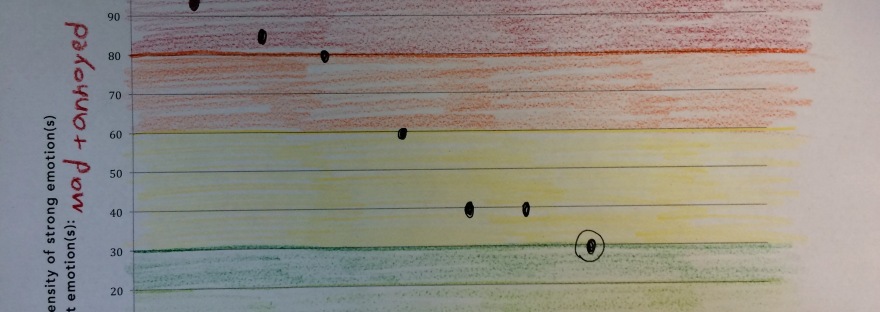Making the Case for the Role of Objective Data in the Subjective World of Emotional-Regulation
Emotional-regulation is inherently subjective: my emotions are mine and mine alone. You may agree or disagree with how I should feel, though you can no more control emotions than the weather. When it comes to emotional-regulation, the goal is all about regulating the way you respond (i.e., behave), despite how you may be feeling, in order to meet the demands of the situation.
If the emotions we feel are out of our conscious control, it follows that asking a child to control his/her emotions is a recipe for failure, anxiety, frustration, and disillusionment. The focus, then, must shift to improving intentional, mindful, conscious control over behavioral responses in the midst of strong emotions. For many individuals, increased activity in the limbic, emotional brain is mirrored by decreased engagement of the cortical, thinking brain. In other words, stronger emotions = less critical thinking and more impulsive reacting.

The challenge with emotional-regulation is that however aware you might be that a situation demands certain calm and collected behaviors, parts of the logical brain want to justify the experiences of the emotional brain. This is why we feel so good and justified (in the moment) when we yell at someone who has said something that triggers a strong, angry emotion. No one likes being told to “calm down” or “take a deep breath” at the height of experiencing a dysregulating emotion (however helpful those suggestions might be). In fact, for many children, the feeling of invalidation that comes with being told to “calm down” ultimately triggers greater emotional dysregulation. Kids, especially those who tend towards the impulsive side of the spectrum, are at a developmental disadvantage when it comes to emotional-regulation; the maturity and brain development that comes with reaching adulthood helps to create a bank of personal experience, world knowledge, and anticipation of future consequences that makes it easier to pause one’s initial reactions in order to devise a more useful response during emotionally triggering situations. While we, as adults, might have great regulation advice for a triggered child, the state of dysregulation can make it impossible for him/her to hear and process the advice. The subjective nature of emotions makes for rocky regulation-coaching terrain.
So what’s the solution? Turn a subjective process into what feels like a data-driven, objective process! Words and advice may feel biased, but numbers don’t lie. The Charting Re-Regulation worksheet is a simple way to help a child objectively see his/her patterns of regulation, and how long it typically takes to go from “super triggered” to “re-regulated.” Here’s how it works:
Step 1: Note the triggering situation and emotion(s) being felt (if this is too triggering in the moment, save this step until later).
Step 2: Mark the intensity of the emotion(s)…
- At the time of the trigger
- After one minute
- After two minutes
- Etc.
Step 3: Notice when the emotional intensity reaches 30% or below. This is usually an indication of being mostly re-regulated and ready to logically process and/or problem-solve.
Step 4 (optional): Record what tools/strategies you used at each phase of re-regulation. In other words, what helped at the 80%-100% range? What helped at the 60%-80% range? What helped at the 30%-60% range? Identifying helpful strategies provides a bank of regulating tools for future triggering situations.


Fill out a new worksheet for each of five or more triggering situations in order to have enough data to determine a pattern for how long it typically takes to feel re-regulated. Three minutes? Eight minutes? What children can glean from their own data is the time frame they need to fill with regulating tools before they can expect to feel calm. An average of three to four minutes in the 80%-100% zone might mean a quick labeling of the emotion(s) with three to four minutes of a distracting brain break (i.e., Daniel Siegel’s Connect and Redirect strategy). Does the re-regulation go pretty fast once the child is below the 80% mark? That might mean that he/she needs some quick, simple sensory and/or mindfulness tools to take up the remaining few minutes in the countdown to calm. Does re-regulation tend to take longer? Strategies like a reading or drawing break might be a better fit for a child who needs more time to truly return to a calm, regulated state.



In the examples included here, the child tends to remain highly dysregulated (80%-100% intensity) for two to three minutes across all situations. He reaches a re-regulated state (30% intensity or below) after six to seven minutes. Using the data he generated and collected, we collaboratively determined that an adult should wait at least seven minutes following a triggering situation to talk with him about what went wrong or how things could have been handled differently. In the meantime, he could pull from his bank of previously useful strategies to remain safe and mindful during the re-regulation process. After seven(ish) minutes, his thinking brain was more engaged and he felt ready to strategize with a peer or adult.
How else can charting re-regulating be beneficial?
- Children receive concrete, visual feedback about the abstract, subjective process of emotional de-escalation. This feedback can be an important reminder to a frequently dysregulated child that he/she can successfully re-regulate!
- Using a simple graph to chart the re-regulation process provides opportunities for children to note whether their emotion(s) changed throughout the process. Did they feel varying “shades” of angry the entire time, or did the emotion change to disappointed or confused? It’s important to remind children that emotions can change, and that we often feel multiple emotions at the same time.
You can access the worksheets using the PDF links below:
Charting Re-Regulation 1-10 min. intervals
Charting Re-Regulation write-in min. intervals
Know of other benefits? Share in the comments!































